'To-day and To-morrow': The 100-year-old book series that predicted a wild and wonderful future
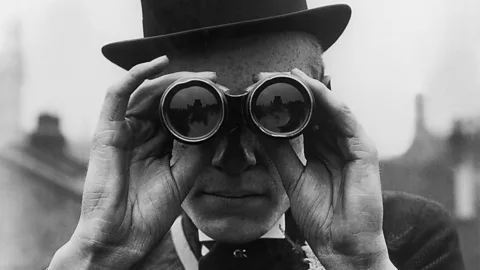 Getty Images
Getty ImagesA century ago, a little-known series of books about the future tackled everything from science to religion to monogamy. Max Saunders argues that it deserves to be rediscovered – and not just for its striking prescience.
One hundred years ago, towards the end of 1923, the geneticist JBS Haldane published a short book imagining the world that lay ahead. Fewer than 100 pages long, Daedalus, or Science and the Future was an extraordinary whistle-stop tour of all the sciences, taking in everything from the future of human reproduction to energy generation.
The book became a sensation, and was arguably one of the first works of science communication to have a wider cultural impact. As well as influencing other scientists, it was read by writers, artists, activists and even politicians like Winston Churchill.
Following Daedalus's success, its publisher Kegan Paul ended up publishing more than 100 additional volumes about the future of anything and everything, in a series called "To-day and To-morrow". Running until the early 1930s, an array of writers, thinkers and intellectuals imagined the future of science and technology, but also so much else: women, religion, clothes, family, humour, justice, censorship, leisure, sleep, alcohol and even swearing. Anything that seemed to have a future was eligible.
On the 100-year-anniversary of Haldane's Daedalus, what can we learn from his influential work, as well as the ambitious To-day and To-morrow series that it inspired?
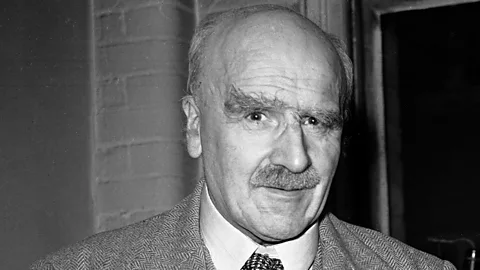 Getty Images
Getty ImagesHaldane's Daedalus was based on a paper he had read in February 1923 to a Cambridge discussion group called the Heretics, known for inviting progressive speakers like the novelist Virginia Woolf.
In the wake of the theory of relativity, and discoveries about the structure of the atom, Haldane thought the important theoretical heavy-lifting had been done in physics, and that its future would really be engineering. He knew that nuclear reactions could unleash immense quantities of energy. But the idea of the chain reaction hadn't yet been formulated, and he couldn't see how humanity could ever control the reactions, thinking it more likely we'd blow ourselves up.
Comment and analysis
Max Saunders is interdisciplinary professor of modern literature and culture at the University of Birmingham and the author of Imagined Futures: Writing, Science, and Modernity in the To-day and To-morrow Book Series, 1923-31.
Later developments – the atomic bomb, nuclear reactors, theories of black holes, God particles, string theory – showed these to be Haldane's blind spots. It isn't enough, though, to point out that the history of prediction is littered with such errors – even though it's true, that doesn't mean we can't learn from how Haldane thought about the future.
In a sense, Haldane's energetic, fearless confidence was what enabled his vision. A biochemist, he thought biology was where the most exciting developments would take place. And here, he was on firmer ground.
The mythical inventor Daedalus is best known as the architect of the Labyrinth in Greek mythology, the father of Icarus, and the designer who devised his son's wings. But for Haldane he is the first genetic engineer, devising the contraption which enabled King Minos' queen, Pasiphae, to mate with a bull, and produce the Minotaur, half man, half bull. By imagining humans learning to intervene in evolution, Haldane foresaw the world of genetic modification we live in today. (Later, he would also coin the word "clone").
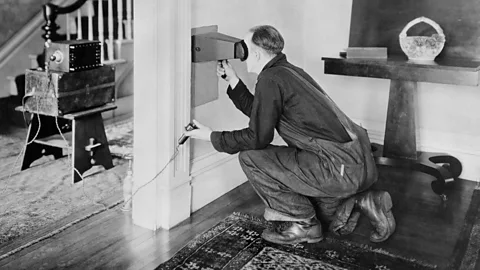 Getty Images
Getty ImagesBut that wasn't the most striking prediction in Daedalus. It is packed with glimpses of our world: wind power, rapid transport and communication, hormone replacement therapy, even environmental catastrophe. A plant bred to reclaim the desert accidentally gets into the seas and turns them purple.
One prediction in particular gripped the attention of readers then and since: what Haldane called "ectogenesis" – the gestation of human embryos outside the body, in machine hosts, or artificial wombs. This must have seemed like science fiction in 1923. It probably still does to many readers now. Yet in 2017 it was announced that an artificial womb designed to nurture premature human babies had been successfully trialled on sheep. In Daedalus, the first ectogenetic child is produced in 1951. It is just a matter of time, and Haldane was ahead of his.
The form Haldane chose for his title became the trademark of most of the To-day and To-morrow series: a classical or mythological name symbolising the topic, followed by a subtitle, usually along the lines of "the future of X".
You may also like:
As well as Daedalus, the Cambridge Heretics would spawn another title. The group's organiser, the linguist and philosopher CK Ogden – who had connected Haldane with Kegan Paul – proposed that his friend the philosopher Bertrand Russell could write a response to Daedalus for the publisher.
Russell's Icarus, or the Future of Science, duly appeared in February 1924, with a notably more pessimistic view of scientific progress. Science, he warned, would be used to further the interests of the powerful, not to enhance human happiness.
Later in the series, Dora Russell – wife of Bertrand – wrote the spirited feminist volume Hypatia, or Woman and Knowledge, which urged the importance of educating women to enjoy their sexuality. For her title, she chose the philosopher and astronomer Hypatia, born in the 4th Century, because she was denounced by Church dignitaries and murdered by a mob. "Such will probably be the fate of this book", Russell wrote in the preface. (Her name appears on the title-page in the rather un-feminist form "Mrs Bertrand Russell", probably out of the publisher's fear that a book so frank about sexual experience might have seemed too shocking unless she were married.)
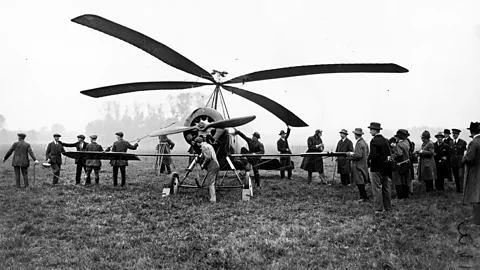 Getty Images
Getty ImagesDaedalus and Icarus have remained well-known to historians of science. But otherwise, the To-day and To-morrow series had disappeared from view until the academic publisher Routledge reissued nearly all of it in 2008. One reason is that predictions are illuminating when they're fresh – but once you're actually in the future they describe, they only have antiquarian interest. The starry-eyed enthusiasms in Popular Mechanics or the BBC technology series Tomorrow's World, where the latest gadget was supposed to transform our lives, rarely made it into our homes.
To-day and To-morrow isn't, for the most part, particularly focused on gadgetry. Even when it is, fewer of its predictions turned out wrong – and often for the right reasons. The writer of Aeolus (1927) thought we'd be using autogyros for short hops. While 1920s helicopter prototypes didn't look practical, this was correct about the future of rotors.
The series is more concerned with the difference that new technologies, new social configurations, might make to daily life. Nor is it in the business of making predictions, exactly. True, it sometimes associates specific innovations with particular dates, as Haldane does with ectogenesis. But the point is to take a possibility and explore it.
The philosophy of the series is that, if society is to improve, we need to generate good ideas for our future. And the best way of testing whether an idea is good or not is to conduct a "thought experiment": to imagine a world in which the idea is implemented, and tease out its possible implications and effects.
It was a form the writer HG Wells had pioneered in the non-fictional books of speculation about the future which he wrote alongside his science fiction, from Anticipations (1901) onwards. He called these "fantasias of possibility" – the idea was to take an emerging technology or social tendency and try to imagine how it might develop.
To-day and To-morrow was the version for the new, post-war generation. Just as subversive, visionary and ironic, but with a 1920s sense of freedom about sexuality and atheism. And where Wells had appeared the single important Edwardian prophet of futurity, To-day and To-morrow was a large, collective effort. The future had become everyone's project.
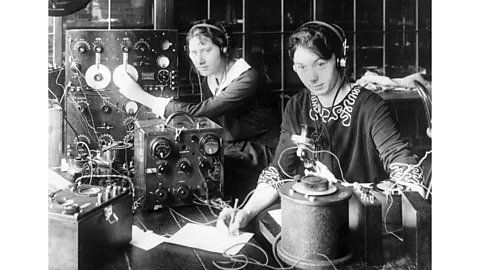 Getty Images
Getty ImagesOne of the To-day and To-morrow volumes that charted such future possibilities particularly spectacularly was called The World, the Flesh, and the Devil (1929), by the young X-ray crystallographer JD Bernal. (Indeed, Bernal's original title was "Possibilities").
At the time, mass-production was bringing cars and other machines to more and more households. Many writers in the series imagined humanity advancing through a combination of body and technology – but Bernal goes much further.
Each of Bernal's three sections tries to imagine possible developments allowing humanity to transcend its limitations. The section on "The World" thinks about how people might travel in space to other planets, especially when Earth's resources run out. Bernal understands that, without the sci-fi trick of "warp drives", the immense distances mean that the travel will take years, even generations. So he imagines huge bio-spheres able to support entire communities on their interstellar journeys.
"Bernal spheres" have inspired science fiction writers ever since. But his section on "The Flesh" is even more visionary – and disturbing. The limitations here are our capabilities and our longevity. Where Haldane proposed outsourcing the gestation of children to machines, Bernal's thought experiment is to put the adult human inside a machine; to replace the body with a machine host which can keep the brain alive – and keep it alive for longer.
These mechanical bodies would augment our strength and our speed. But they also offer possibilities for extending our senses. If a brain could be connected to artificial eyes, ears and so on, there would be no reason why we couldn't become able to hear sounds outside the audible frequency range, or see infra-red and ultra-violet light. Bernal even suggests an X-ray sense.
And, in one of the stunningly visionary moments even by his own high standards, he proposed we could be directly connected to radio. This was 1929. The BBC was still young; television still a novelty. You might think he was imagining being able to tune directly into the radio without bulky wireless sets, like the portable audio we have in our phones. But Bernal was thinking beyond broadcasting, and anticipating interactivity. He imagines his future humans communicating directly with each other – including with their space-travelling fellow-humans. He effectively imagined something like the internet, more than a decade before the arrival of the first electronic computer. Not the internet of things, but the internet of minds.
If this sounds like contemporary proposals to implant computer chips in the brain, that's because technology is still catching up with some of these 1920s pioneers. For Bernal though, the interest is in the ideas, not the possible commercialisations. You'd think having effectively invented the cyborg – another staple of sci-fi – Bernal would have stopped there. But what makes him a genius futurologist is what made him such a good scientist.
Once Bernal has an idea, he pushes it as far as he can make it go. And where the idea of the human race all interconnected by wireless leads him, is to the sense of a new kind of human intelligence; what sci-fi writers sometimes call a "hive mind", or a "superintelligence". Here too, he's anticipating our sense of how the internet has transformed information and knowledge, and also anticipating some of today's debates about AI.
 Getty Images
Getty ImagesAlongside such bold visions, the To-day and To-morrow series is also a treasure-trove of wonderful writing about a diverse selection of topics. The volumes on architecture, cosmology, flying, physics, and wireless, are all superb. Some excellent ones cast the net wider. Quo Vadimus? (1925), by the physicist EE Fournier d'Albe gives a survey of where an increasingly technological, increasingly interconnected, civilisation is heading. Novelist Winifred Holtby's Eutychus, or the Future of the Pulpit (1928), is less concerned with the Church than with a crisis in authority, as new intellectual fashions spring up in the no-man's-land between religion and science. Euterpe (1926), by the librarian Lionel McColvin, wonders what mechanical reproduction – especially the recording of music – will do to our engagement with the arts. There are also very entertaining volumes on the future of food, and the future of nonsense.
The nurse and writer Vera Brittain's Halcyon (1929) is subtitled "The Future of Monogamy". There is some of that, certainly, though what she means by monogamy is really the form of long-distance relationship that she herself was cultivating – made possible by air travel and telephones. Halcyon is mostly devoted to women's rights in general, though, It is delivered through a kind of dream vision of a book written in the distant future, by a woman professor, about what for her is ancient history – but for 1929 was still far in the future. Brittain is then able to imagine a whole sequence of advances in legislation enshrining women's rights, presented as if they were already familiar fact.
This trope of imagined "future history" appeared in many of the volumes. It enabled them to make the future seem real, without having to clutter it up with the unreal paraphernalia and plots of sci-fi. But also – and this is one of the great strengths of the series – to imagine the impact on everyday life of profound changes, whether in technology, society, or human nature. Brittain proposes something like a movie streaming service, suggesting it would reduce boredom and make people less likely to cheat on their partners. Is there evidence that this has happened? No. But it's a humorous glimpse of a possibility – and her broader vision has proved surprisingly accurate, including legislation to protect women's rights in areas like financial independence or maternity leave, or even Oxford University having women professors. It is such broader visions that make the To-day and To-morrow series so interesting and worthy of our attention 100 years later.
So often when we look to the future nowadays, we do so through certain narrow lenses: the future of technology, the climate, or work, for instance. But what makes this series so inspiring is its breadth, ambition – and the willingness to imagine the wildest of possibilities.
*Max Saunders is interdisciplinary professor of modern literature and culture at the University of Birmingham and the author of Imagined Futures: Writing, Science, and Modernity in the To-day and To-morrow Book Series, 1923-31.
--
If you liked this story, sign up for The Essential List newsletter – a handpicked selection of features, videos and can't-miss news delivered to your inbox every Friday.
